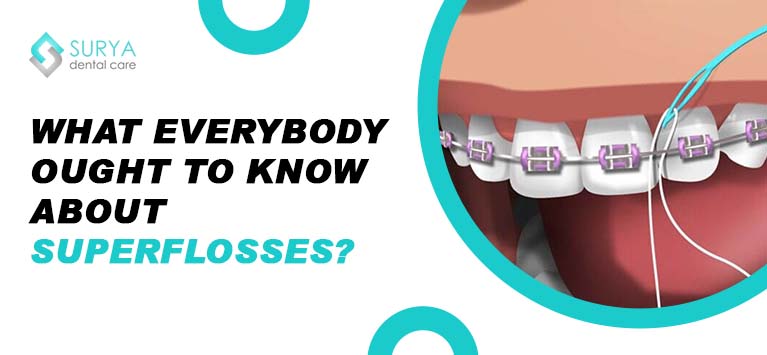![]()
The in-between teeth spaces are hard to clean with brushing alone. The toothbrush bristles are effective in cleaning the surfaces of a tooth, whereas mouthwashes can dislodge the particles wedged in the interdental spaces to a certain extent alone. Hence you should incorporate flossing into your oral hygiene regimen.
Flossing can scrape down the clingy microbial film coated on the teeth surfaces, interdental gum edges and eliminate bacteria hiding in the tiny spaces of your mouth. On contrary, the regular flossing strings are quite ineffective in cleaning the areas around replacement teeth like dental bridges, dental implants, and others.
Likely, traditional brace wearers also feel difficult to floss as the archwire intervenes in the teeth cleaning activity.
If your flossing activities are interrupted due to wearing braces or prosthodontic teeth, we advise you to replace your conventional dental floss with a superfloss.
What is Superfloss?
Superfloss is a kind of floss made from yarn-like material. It consists of 3 components:
- A 10 cm long stiffened dental floss thread
- A spongy floss made up of cotton or nylon threads coated with wax
- A wax-coated plain dental floss thread
Regular floss allows you to floss underneath the gum, whereas the stiffened floss thread helps you thread the floss underneath an orthodontic appliance or restoration. The fuzzy section efficiently dislodges the particles lodged underneath the restorative appliance.
Who should use Superfloss?
Superfloss is otherwise known as orthodontic floss, but it does not mean only brace wearers can use this appliance. It is ideal for everyone so that you can replace your regular dental floss with a superfloss.
Besides brace wearers, superflosses are widely prescribed for people with fixed dental restorations like implant teeth, bridges, crowns, fixed dentures, etc. It aids their oral hygiene as follows:
- Cleaning the implant bars
- Cleaning retention arches
- Cleaning the juncture point where a restoration appliance meets the natural tooth.
- Cleaning the gaps between teeth after the loose teeth are strengthened
How to use a Superfloss?
It is essential to use a flossing string correctly else you might injure the gum tissues. It applies to all types of dental floss, including superfloss. Here are the instructions to use a superfloss properly:
1) Take a superfloss strand and hold it by the stiff end with your thumb and index finger. 2) Place the other end of the superfloss between the archwire and a tooth. Push it gently until the fuzzy section reaches the area. 3) Now glide the teeth gently up and down with the spongy floss. After completing on the left side, repeat it on the right side. 4) While cleaning dental bridges, place the floss between teeth. Then pull it forward and backward to clean the interdental spaces effectively.
Bottom line
Bacteria buildup is common in the junction where a dental crown meets gums. Similarly, food particles get trapped in the tiny space between teeth and the archwire of braces. Hence you should give more attention to cleaning these regions to avert bacterial invasion in teeth and gums.
Flossing accompanied by toothbrush and oral is pivotal to cleaning these areas. However, regular flosses do not help, so superflosses are recommended.
Superflosses are considerably more costly than traditional dental floss and require some time to become accustomed to. Aside from cleaning interdental spaces with dental appliances, superflosses are the perfect option to clean wider gaps between teeth.
Do you want to know more about this dental hygiene appliance? Contact our dentists in Trichy here.



